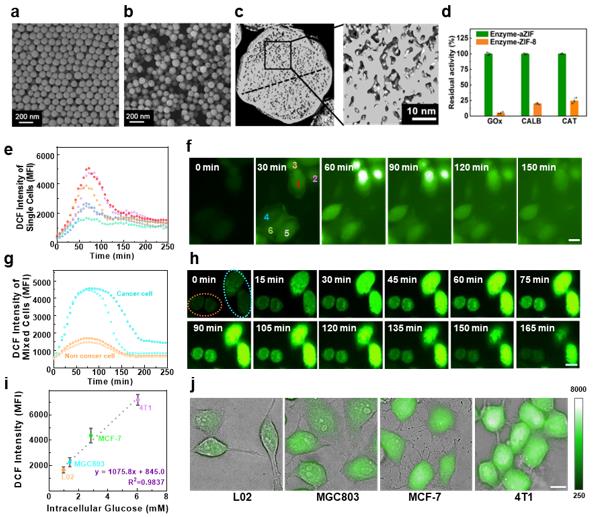[ Instrument Network Instrument R & D ] Recently, the Institute of Process Engineering of the Chinese Academy of Sciences cooperated with Tsinghua University and Tianjin University to develop a new dosage form based on the amorphous metal-organic framework, which can achieve efficient intracellular delivery and catalysis of enzyme molecules. In situ detection of cell metabolites at the level. The work was published in Nature Communications.

Nanoparticles have made important contributions to the development of biological dosage form engineering. Ma Guanghui and Wei Wei, researchers of the National Key Laboratory of Biochemical Engineering and Biomaterials Team of the Institute of Process Engineering, conducted systematic research on this, and discovered and created a series of new nano-microparticle formulations, which have been successfully used in tumors, diabetes, hepatitis B, etc. Prevention, diagnosis and treatment of major diseases. Related work has been published in Nat Mater 2018, 17, 187, Nat Commun 2017, 8, 14537, Sci Adv 2019, 5, eaaw3192, Adv Mater 2019, 31, 1801159, Adv Sci 2017, 4, 1700083, ACS Nano 2015, 9 , 4925-4938, etc., some dosage forms have entered preclinical and clinical research.
Limited by the barrier effect of the cell membrane and degradation factors inside the cell, it is difficult for foreign enzyme molecules to enter the cell to play an efficient catalytic reaction. To solve this problem, the research team prepared a new type of amorphous metal-organic framework nanoparticles for the loading of enzyme molecules.
The dosage form can overcome the cell membrane barrier and efficiently deliver enzyme molecules into cells. At the same time, the protective effect of nanoparticles is used to ensure the natural activity of the enzyme molecules. Further, the mesoporous structure (3-6 nm, State structure is only 1 nm), which enhances the mass transfer diffusion of substrates and products (Figure 1 ad). Based on the above advantages, this dosage form can be used for in situ detection of intracellular metabolites.
Taking glucose as an example, the product catalyzed by this dosage form can react with corresponding fluorescent probes. With the help of high-content technology, it can achieve real-time quantitative detection without damage at the single cell level, which can be used to judge the metabolic state of cells and normal cells and cancer. The differentiation of cells (Figure 1 ej) provides new ideas for the monitoring of chronic diseases and the early diagnosis of cancer.
Scanning electron micrographs of amorphous nanocarriers (a) and enzyme-amorphous nanocarrier complexes (b); (c) Cryo-EM imaging showing the structure of amorphous carriers; (d) Apparent activity of enzyme molecules after loading (E) and the corresponding high-content image (f) of the fluorescence intensity changes of cells under different metabolic states; (g) and the corresponding high-content image of the fluorescence intensity changes of normal liver cells (orange) and liver cancer cells (blue) ( h); (i) the relationship between intracellular glucose concentration and fluorescence intensity of different cells; (j) the corresponding image when the fluorescence intensity of each cell reaches its peak.
Wu Xiaoling, Yue Hua, and Zhang Yuanyu are co-first authors of the paper, and Ge Jun, Wei Wei, Zhang Lin, and Li Sai are co-corresponding authors. The research was supported by the National Natural Science Foundation's Excellent Youth Fund and the National Key R & D Program.
Rutile Titanium Dioxide
Rutile Titanium Dioxide is used in coatings, plastics, paper, printing inks, chemical fiber, rubber, cosmetics and other industries. It has a high melting point and is also used to make refractory glass, glaze, enamel, clay, high temperature resistant laboratory utensils, etc.
At the same time, titanium dioxide has a good UV shielding effect, and is often incorporated into textile fibers as a sunscreen. Ultra-fine titanium dioxide powder is also added to sunscreen cream to make sunscreen cosmetics.
Titanium dioxide is not only used as a coloring agent in the rubber industry, but also has the functions of strengthening, anti-aging and filling. Titanium dioxide is added to white and colored rubber products. It is resistant to sunlight under sunlight, does not crack, does not change color, has high elongation and is acid and alkali resistant. Titanium dioxide for rubber is mainly used in car tires, rubber shoes, rubber flooring, gloves, sports equipment, etc., generally anatase type. However, when used in the production of automobile tires, a certain amount of rutile products are often added to enhance the anti-ozone and anti-ultraviolet capabilities.
Rutile titanium dioxide
Rutile titanium dioxide
Titanium dioxide is also widely used in cosmetics. Because titanium dioxide is non-toxic and far superior to lead white, almost all kinds of fragrant powder use titanium dioxide instead of lead white and zinc white. You only need to add 5%-8% of titanium dioxide to the fragrance powder to get a permanent white color, making the fragrance smoother, having adhesion, absorption and hiding power. In gouache and cold cream, titanium dioxide can weaken the greasy and transparent feeling. Titanium dioxide can also be used in various other spices, sunscreens, soap flakes, white soap and toothpaste.
The glaze made of titanium dioxide has strong transparency, low quality, strong impact resistance, good mechanical properties, bright colors, and is not easy to be polluted. Titanium dioxide for food and medicine is titanium dioxide with high purity, low heavy metal content and strong hiding power.
